
Product test
Meta Quest Pro in the test: Unfinished harbinger
by Samuel Buchmann

Are Apple’s new glasses a revolution in computing or just an expensive toy? I spent a few hours searching for the future in the Vision Pro. In doing so, I encountered genius, potential and dead ends.
«There’s no such thing as headphones for video,» Steve Jobs once said. Nineteen years later, Apple made some. The Vision Pro is here – a headset for virtual (VR) and augmented reality (AR), which Cupertino’s marketing calls a «spatial computer». It’s initially only available in the USA. It’ll probably be months before it comes to Europe.
Following the announcement, I was sceptical as to whether the Vision Pro offers any added value. After being able to try it out for a few hours, I’m faced with a paradox. Many of my fears have come true. Starting at 3,500 US dollars, the Vision Pro is an irrational product. But I still want the thing.
I’m standing in the winter garden of Digitec Galaxus customer René Vogel. The Apple fan picked up a Vision Pro in New York and let me try it out for a few hours. He himself is very enthusiastic, as he explains in an interview coming soon.
I’m also amazed as I put on the Vision Pro for the first time. In standard mode, I’m led to believe these are transparent glasses. Cameras film my surroundings and feed them live into the displays. This is called pass-through mode. Digital menus, windows and three-dimensional objects float in physical space. They stay in place as if they were real. There’s no latency between reality and what I see.
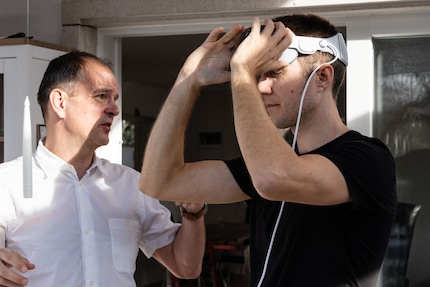
Operation seems magical – I don’t need a controller. My eyes are the cursor, my hands the mouse button. To select something, I look at it and bring my thumb and index finger together. It doesn’t matter where I do this as long as it’s within the headset’s field of vision. I can hold things and move them around the room, or zoom in and out with two hands. The concept is as intuitive as multitouch on a smartphone.
After the first five minutes, I have to pick my jaw up off the floor. Am I experiencing a product as revolutionary as the first iPhone?
Certain parallels can’t be denied. As with the iPhone, Apple hasn’t invented a new product category with the Vision Pro. At its core, it’s a VR headset with AR simulation – no matter how often Tim Cook calls it a «spatial computer». The basic idea is the same as that of the Meta Quest Pro, which I tested over a year ago.
As with most Apple products, the revolution lies in the implementation. The Vision Pro is the first VR headset I don’t want to take off after half an hour, just like the iPhone was the first smartphone I actually wanted to use.
Five things make the Vision Pro better than anything before it:
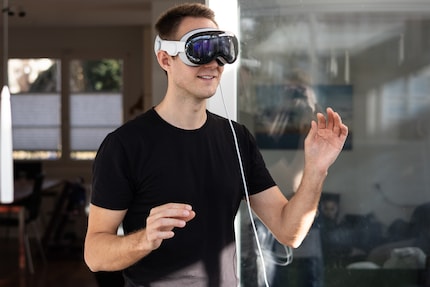
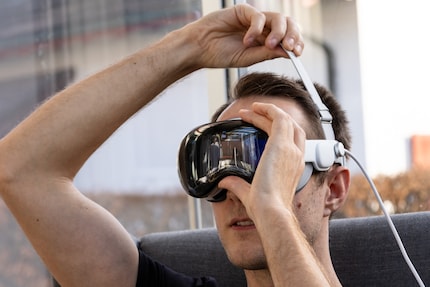
This Herculean technical feat is expensive. Very expensive. The Basic Vision Pro with 256 gigabytes of memory costs 3,499 US dollars in the States. If you want 1 terabyte, the price climbs to 3,899 dollars. If you’re short-sighted like me, you’ll have to pay 149 dollars for the corrective inserts. Do you want a case or a replacement battery? That’ll be 199 dollars each. Add to this VAT – and in Europe, probably Apple’s usual surcharge of around ten per cent.
A Vision Pro with 512 GB of memory and some accessories is likely to cost over 4,500 francs in Switzerland. Private imports from the USA are currently changing hands for at least 5,500 francs.
For this price, you get the best VR glasses around. But that doesn’t make it a perfect product by any means. The magic of Vision Pro is fragile, and there are things that temporarily disenchant it. Apple could improve some of these in future generations. Others are dead ends from the off.
Areas with potential for improvement:
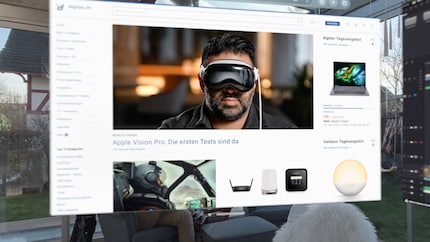
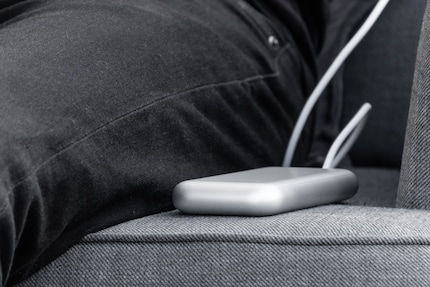
Concepts that fail from the get-go:
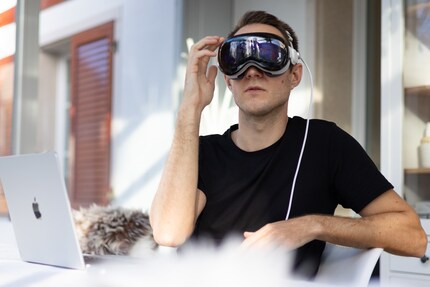
The Vision Pro is a face computer that I have to put on. Even if the glasses are comfortable, they’re still heavy. They still ruin hairstyles. There’s still a rechargeable battery connected by cable. For me to put up with this foreign body on my face in the long term, it has to offer tremendous added value. The threshold for this is massively higher than for a handheld computer, which we now call a smartphone. In some situations, the Vision Pro overcomes this hurdle. In others, there’s potential. And in some, it’ll never get there.
The flagship application for Apple’s VR glasses. The Vision Pro is the best mobile movie theatre there is. It conjures up a huge canvas in front of me, which I can move and scale as I wish. On the ceiling above the bed, into a virtual environment when I’m on an aeroplane, or on the wall in an apartment without a television. It’s so handy and comfortable that I’d probably watch a movie in the virtual cinema more often, even in my apartment with a TV. The glasses also open the door to 3D content – albeit not every option.

The gaming sector is still underdeveloped. The best way to use the glasses is as a face TV with an external gamepad. Either for games on a Mac or perhaps soon with native apps for cloud gaming services such as GeForce NOW. VR games could also be possible, but here headsets with controllers such as the PSVR2 or the Meta Quest 3 have a clear advantage.
You can also work with the Vision Pro. Native VisionOS apps are still rare, but this will improve over time. Until then, I’ll have to connect my Mac and think of the glasses more as an external screen. The virtual monitor has a resolution of 2,560 × 1,440 pixels. As a stress test, I try to grade a video in DaVinci Resolve. The picture is too dark, and the foveated rendering bothers me. Surfing the web or writing text, on the other hand, works wonderfully. Multiscreen setups like on the Mac interface aren’t possible. This doesn’t bother me. I can still wallpaper the whole room with VisionOS apps like Safari.
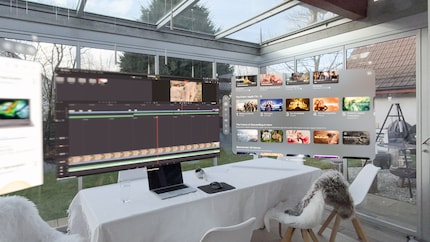
Would I do this voluntarily at home or in the office? Probably not; a real monitor is still better. And I don’t have to strap on a face computer. The glasses becoming lighter and even better wouldn’t change this. The situation is different on the road. On an aeroplane or in a hotel room, the huge work surface would be worth the ruined hairstyle.
For me, the potential of augmented and mixed reality (MR) is a complete unknown. For the latter, virtual objects interact with the physical world. Enthusiasts have long been predicting revolutionary applications for it. Microsoft tried to break into the professional MR market with the HoloLens. Largely unsuccessfully, development was discontinued. It remains to be seen whether Apple’s appeal can lure developers and users. So far, there have been a few nice demonstrations such as the JigSpace app, which allows you to place a virtual aircraft engine in your room and take it apart.
There are many paths for further innovation. René works in the museum sector, for example, and could imagine virtual tours for people who are unable to make a physical visit. Or historical hiking trails, some of them enriched with digital content. For example, a ruin could be turned into the original building.
How well this can be implemented also depends on how many people will one day own such a device. If the glasses reach the mass market, the hope is several people will be able to watch the same content. What I only really realised during my test is that I’m alone with the Vision Pro. It has a socially isolating effect. Watching a movie with friends? Showing your colleague something on the monitor? Holding something up to the camera in a video call? No dice. In a conversation with a real person, the other person at best only sees the strange simulacrum of my eyes. No true connection to be found.
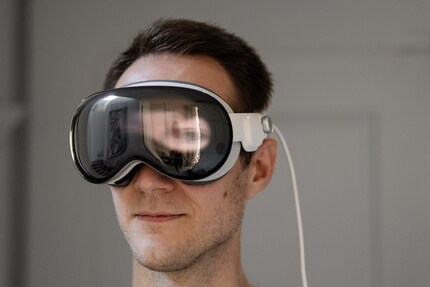
The Apple Vision Pro is exciting, a demonstration of Apple’s engineering prowess. It’s the first pair of VR glasses that I actually want. It’s more beautiful, sharper, more precise, more comfortable and more sophisticated than anything that has come before. Thanks to Apple’s appeal, seamless integration into the ecosystem and clever marketing, it’s generating hype that other manufacturers such as Meta can only dream of.
Is the Vision Pro the next iPhone? The computer of the future? No. What it is, however, is an excellent implementation of a well-known idea. But it ends up in the same dead end as other face computers. The cons outweigh the pros in many situations. I have to strap the thing to my head and I’m constantly looking at the world through cameras and displays. This isolates me socially; those around me don’t see what I see. Only a few applications offer enough added value that I’d put up with it all. This won’t change with future generations or improved technology.
It’s a compromise that Apple CEO Tim Cook has deliberately made. The Vision Pro is a simulation of the physically transparent AR glasses that he actually wants to build. Whether he’ll ever be able to craft this is written in the stars. And whenever the technology is ready, this future concept will also involve compromises.
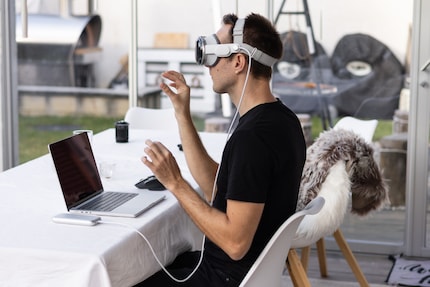
At present, I see two main areas of application for the Vision Pro – as a mobile movie theatre and as an external display for a Mac. The first experience especially is so good that I’d even use it at home. The latter may be inferior to a stationary workstation, but it offers real added value when on the move. Games, AR and MR content could also offer this in the future. But I don’t rate a product according to what might be.
All things considered, is the Vision Pro worth its astronomical price? Only for a tiny target group of enthusiasts. You’re paying the development costs for a futuristic first-generation pioneer product that doesn’t replace anything, but at best complements it. If you’re aware of this and don’t care, Apple’s glasses won’t disappoint. As a nerd, I find it hard to resist.
Header image: David LeeMy fingerprint often changes so drastically that my MacBook doesn't recognise it anymore. The reason? If I'm not clinging to a monitor or camera, I'm probably clinging to a rockface by the tips of my fingers.